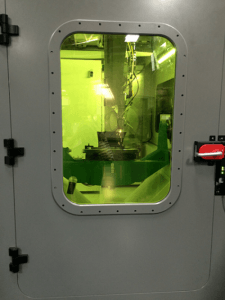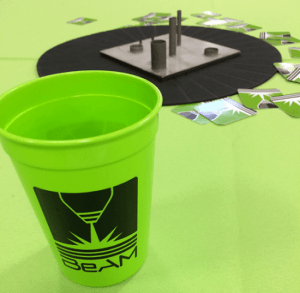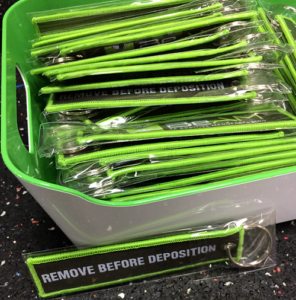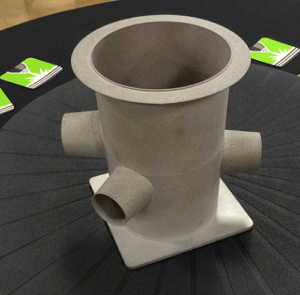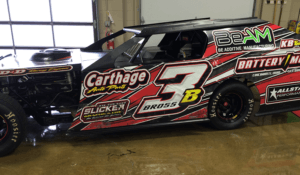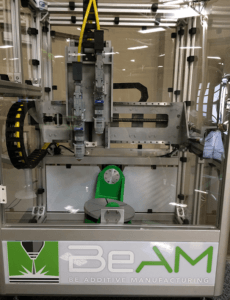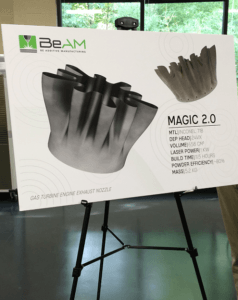 We’ve been eagerly following the progress of BeAM Machines SAS, founded in France, since 2015. This winter, the company, which specializes in Directed Energy Deposition (DED) technology, made a successful jump to the US market when it opened a new facility in Ohio for its US subsidiary, BeAM Machines Inc. Soon after the doors opened at the company’s North American Solutions Center, BeAM’s Magic 2.0 Additive Manufacturing System was delivered there, but the facility was still very much a work in progress when 3DPrint.com was granted an exclusive site tour this spring. Yesterday, I had the exciting opportunity to drive down to BeAM’s North American Solutions Center in Blue Ash, just outside of Cincinnati, for its official open house event. After a frustrating battle with freeway traffic, it was a pleasure to be greeted by a line of easy-to-read BeAM Machines Inc. signs in front of the building, in the company’s signature green, white, and black color scheme.
We’ve been eagerly following the progress of BeAM Machines SAS, founded in France, since 2015. This winter, the company, which specializes in Directed Energy Deposition (DED) technology, made a successful jump to the US market when it opened a new facility in Ohio for its US subsidiary, BeAM Machines Inc. Soon after the doors opened at the company’s North American Solutions Center, BeAM’s Magic 2.0 Additive Manufacturing System was delivered there, but the facility was still very much a work in progress when 3DPrint.com was granted an exclusive site tour this spring. Yesterday, I had the exciting opportunity to drive down to BeAM’s North American Solutions Center in Blue Ash, just outside of Cincinnati, for its official open house event. After a frustrating battle with freeway traffic, it was a pleasure to be greeted by a line of easy-to-read BeAM Machines Inc. signs in front of the building, in the company’s signature green, white, and black color scheme.
 Upon entering the warehouse area, visitors had the opportunity to enter a raffle to win a free iPad before continuing into the facility, which was filled with tables that featured 3D printed sample parts as centerpieces. I had missed the lunch rush but was just in time for dinner, which included pizza from Cincinnati chain LaRosa’s and a selection of beverages, including beer from Rhinegeist Brewery, another Cincinnati original and, according to Tim Bell, BeAM’s Vice President of Business Development and General Manager of the company’s US operations, a favorite watering hole of the company’s.
Upon entering the warehouse area, visitors had the opportunity to enter a raffle to win a free iPad before continuing into the facility, which was filled with tables that featured 3D printed sample parts as centerpieces. I had missed the lunch rush but was just in time for dinner, which included pizza from Cincinnati chain LaRosa’s and a selection of beverages, including beer from Rhinegeist Brewery, another Cincinnati original and, according to Tim Bell, BeAM’s Vice President of Business Development and General Manager of the company’s US operations, a favorite watering hole of the company’s.
 There was a steady flow of people arriving, but the space was big enough that it never felt overcrowded. I learned that many people just stopped in because they saw the company’s open house signs in front of the building
There was a steady flow of people arriving, but the space was big enough that it never felt overcrowded. I learned that many people just stopped in because they saw the company’s open house signs in front of the building
“We were absolutely blown away – there were a couple hundred people here at lunchtime,” Bell told me. “We were very pleased.”
We support our own in Ohio, and Bell, a Cincinnati native, told me that earlier visitors had included the mayor and the economic development director of “business-centric” Blue Ash; he also mentioned that many of the company’s business vendors are located nearby. There had also been visiting representatives from the University of Dayton Research Institute (UDRI), the Air Force Research Laboratory (AFRL), the University of Cincinnati, and Cincinnati State University; the latter offers an Intro to Additive Manufacturing Course that’s geared toward machinists.
 BeAM has been working to build relationships with local learning institutions, and Bell told me that a consortium of Cincinnati universities was working toward developing an additive manufacturing curriculum.
BeAM has been working to build relationships with local learning institutions, and Bell told me that a consortium of Cincinnati universities was working toward developing an additive manufacturing curriculum.
Bell said, “There’s a lot going on in Cincinnati for additive manufacturing.”
 I took my time wandering around the large warehouse, which is only part of the 20,000-square-foot facility, checking out all of the various sample parts and peeking into the Metrology Lab, where there were even more parts lined up on a table; the few tables without physical parts were topped by Lenovo tablets showing videos of the company’s technology in action. More than just being interesting centerpieces, all of the parts were a clear illustration of what’s possible through additive manufacturing.
I took my time wandering around the large warehouse, which is only part of the 20,000-square-foot facility, checking out all of the various sample parts and peeking into the Metrology Lab, where there were even more parts lined up on a table; the few tables without physical parts were topped by Lenovo tablets showing videos of the company’s technology in action. More than just being interesting centerpieces, all of the parts were a clear illustration of what’s possible through additive manufacturing.
A race car emblazoned with a BeAM Machines logo was parked by the door; the company sponsors Bross Racing, which races the car in nearby Lawrenceburg. BeAM also had its small demo machine set up, which has a 1/2 scale build envelope of the Modulo and offers a good demonstration of the company’s five-axis machines. Then it was time to check out the special AM Room, which I’ve heard so much about.
There were four video screens outside the room that will eventually link right to the five-axis, 5.2 kg Magic 2.0, showing the status of the machine and its current build, live camera feeds to the machine’s melt pool and deposition, and the safety status of the room.
 Inside, the Magic, which features a build volume of 1200 x 800 x 800 mm, was busy building a gas turbine engine exhaust nozzle; a completed sample of the part was on a nearby table. Bell explained that they’d completed a flawless dry run of the nozzle on the flagship machine the day before, and on the morning of the open house they’d come in, put on a new build plate, and started a new nozzle before Murphy’s Law got involved with a machine malfunction, which had been cleared up by the time I arrived. Bell said the part took 11.5 hours to build, and explained that if “you were trying to produce that part from traditional machining it would be weeks.”
Inside, the Magic, which features a build volume of 1200 x 800 x 800 mm, was busy building a gas turbine engine exhaust nozzle; a completed sample of the part was on a nearby table. Bell explained that they’d completed a flawless dry run of the nozzle on the flagship machine the day before, and on the morning of the open house they’d come in, put on a new build plate, and started a new nozzle before Murphy’s Law got involved with a machine malfunction, which had been cleared up by the time I arrived. Bell said the part took 11.5 hours to build, and explained that if “you were trying to produce that part from traditional machining it would be weeks.”
It was fascinating to watch the metal powder DED technology in person, and I went back to the controlled environment of the AM Room, with its ESD (electrostatic discharge) floor and located next to a bay filled with post-processing equipment and a box interestingly labeled ‘Box of Broken Dreams,’ at least four times to see how the part was progressing. The machine, which is housed inside a very large box, allows for multiple angles of approach, and has Siemens 840D Control and a MacroCLAD 24Vx Deposition Head; options and upgrades include a Renishaw MP250 Probe and a three-axis secondary build table.
When I asked about BeAM’s machine offerings, the focus was on the Modulo, which will be available next year.
Bell told me, “The Modulo has the most interest because it can be operated as a factory in the field, it could be flown out to an oil rig and do repairs on site. The current configuration of machines, even the Magic – you have a large electrical cabinet, you have a laser and a chiller and a fume extractor. The Modulo, everything is contained in one unit. So basically you plop it down, you put electric and gas into it, and you’re building parts.” He laughed and said, “I made that sound much simpler than it actually is, but that’s the theory behind it – simplicity. The Navy could put it on a ship, you can put it on a trailer and take it out to a conflict zone and do repairs.”
 I also had the pleasure of speaking with Jon Caliguri, a Sales Engineer with local Autodesk master reseller Design & Software International, Inc., who gave me a demonstration of the PowerMill Ultimate software that BeAM uses. PowerMill, which is dedicated to DED technology, fully supports five-axis machines and offers user-defined parameters and “the ultimate control to getting a specific result.” The software’s native interface works directly with Vericut software as well, which had a table right next to Caliguri.
I also had the pleasure of speaking with Jon Caliguri, a Sales Engineer with local Autodesk master reseller Design & Software International, Inc., who gave me a demonstration of the PowerMill Ultimate software that BeAM uses. PowerMill, which is dedicated to DED technology, fully supports five-axis machines and offers user-defined parameters and “the ultimate control to getting a specific result.” The software’s native interface works directly with Vericut software as well, which had a table right next to Caliguri.
“Autodesk is a giant in their industry. We’re proud to be using their product and working with them,” Bell told me. “We’re not a software company. We have no interest in selling software. But we have to use the software like our customers do, so we want to make sure that we choose the best software to use, then tell our customers, ‘Here’s what we use, because it works really well.'”
I knew Belgium-based additive manufacturing software company GeonX would have some dedicated desks at the BeAM facility, and asked about their arrival.
“GeonX is not here yet, but the plan is to have one of their engineers here on site,” Bell explained. “Their software suite for additive is perfectly suited to what we do. We have common investors…GeonX is a great product, and we’re proud to be working with them as well.”
Bell was kind enough to take a few minutes away from the event to speak with me about the facility’s growth. In May, five employees were working there, which has now gone up to six, with a planned ten by the end of the year; he said that the maximum could possibly be 14, “so we’ll see how that goes.”
When I asked him if there had been any big changes since 3DPrint.com’s visit in May, he said, “I wouldn’t really say any big changes, just the evolution happening as planned, and I think that’s the most important thing is that we’re on track. We’re importing machines from France, we have plans to build machines in Cincinnati in the near future, those are still on track. Hiring people, on track with that…we’re growing fast. I think that’s the easiest way to state that.”
I had wondered if the facility was working on any interesting custom projects, and he mentioned again the materials development work they are doing.
“Customers use specific materials every day because that’s what they have available to them, and with our technology, you can build gradient materials. So the part could begin building as stainless steel, and over the build course it could change over and become Inconel at some point. That’s very unique to DED versus a powder infusion system. We have customers who are developing very specific materials with material properties they can’t get from forging or casting.”
While he couldn’t share any of the proprietary chemistries, he said, “Imagine if you can take a current known aerospace material that did very well at high temperatures for very specific things but it would be really nice if it could bend easily and go back to shape. That ductility that you need in some components…well, there’s elements they could add to that, but you can’t produce it traditionally. With our technology they could add those elements into the powder, print the part, and have new material properties that you couldn’t have before.”
The Blue Ash facility also features a physical and virtual training room, which offers advanced training opportunities for employees, customers, and even those local universities.
“Our biggest problem today is workforce,” Bell said when I asked what would help speed up adoption of the technology. “The number of application engineers for the DED technology are very, very few. We’re in the process of selling a machine where we will train their engineers here. We’ll deposit the engineers when we deposit the machine,” he said half-jokingly. “We have to build these people, we have to build this workforce up. There are people who have very specific skills who are easy to train for this…your advanced machinists who program 5-axis milling machines today, they’re ideal candidates. Other ideal candidates are process engineers who are specialists in welding processes…they understand the melt pools and the geometries and nuances of melting materials.”
“We have to get these people and we have to educate them, and that’s why we have the training room here. We’re setting up a lot of training…our suppliers will come in and train, and so will some of the software companies.”
It was a great event, filled with good food and drink and a lot to see and learn. Spirits were high, and it was also enjoyable to see several employees’ children attending in miniature BeAM Machines Inc. shirts; one young girl even helped check me in to the open house and politely offered to get someone to help me when I asked a question!
Check out more pictures from my visit below:
- Bross Racing car
- BeAM Demo Machine
- Autodesk PowerMill Ultimate
Discuss in the BeAM forum at 3DPB.com.
[All images: Sarah Saunders for 3DPrint.com]
Subscribe to Our Email Newsletter
Stay up-to-date on all the latest news from the 3D printing industry and receive information and offers from third party vendors.
You May Also Like
Profiling a Construction 3D Printing Pioneer: US Army Corps of Engineers’ Megan Kreiger
The world of construction 3D printing is still so new that the true experts can probably be counted on two hands. Among them is Megan Kreiger, Portfolio Manager of Additive...
US Army Corps of Engineers Taps Lincoln Electric & Eaton for Largest 3D Printed US Civil Works Part
The Soo Locks sit on the US-Canadian border, enabling maritime travel between Lake Superior and Lake Huron, from which ships can reach the rest of the Great Lakes. Crafts carrying...
Construction 3D Printing CEO Reflects on Being Female in Construction
Natalie Wadley, CEO of ChangeMaker3D, could hear the words of her daughter sitting next to her resounding in her head. “Mum, MUM, you’ve won!” Wadley had just won the prestigious...
1Print to Commercialize 3D Printed Coastal Resilience Solutions
1Print, a company that specializes in deploying additive construction (AC) for infrastructure projects, has entered an agreement with the University of Miami (UM) to accelerate commercialization of the SEAHIVE shoreline...




